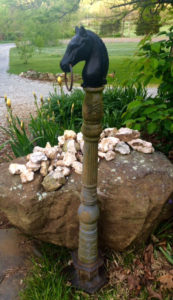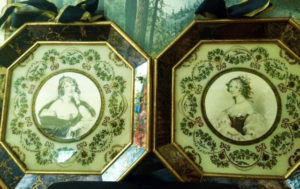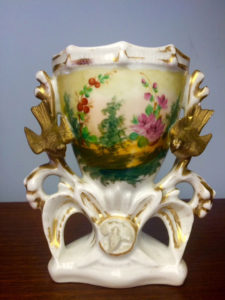by Lisa C. Cantwell
Dear Reader: This is a column to help you determine the history and value of your heirlooms, attic finds, flea market purchases, or antique items. Please send a picture and description of your piece, such as how you acquired it and any details about its history, to tomandlisa@wildblue.net. I’ll research any item, whether it’s a piece of furniture, a painting, a tool, a doll, a figurine, or an article of clothing. An approximate value will be determined to inform you if it’s a “Trinket or Treasure.” Please submit all pictures and questions by the preceding 15th of the month for possible publication in the next monthly issue of The Catoctin Banner. All inquiries will be answered; however, only those selected for publication will include approximate value assessments. Furthermore, not all submissions may be published in the Banner due to space considerations. Please include your name or initials and where you reside. Thank you and happy treasure hunting!
“My mother-in-law gave me this hitching post that she found in an antique mall. It’s 42 inches high and has some rust. Is it old and does it have value? Should I display it outside?”
— Leigh L., Waynesboro, PA
 Hitching posts date from very early days of iron-making to the early 1900s, before the automobile really took off.
Hitching posts date from very early days of iron-making to the early 1900s, before the automobile really took off.
It appears that your post does have some rust on the base, but the head has been replaced, as it’s different in tone and doesn’t match the base in the quality of iron. In other words, it was likely added later and spray-painted. The base is very smooth, lacking the granular pock marks found on reproduction casts, so that is a sign that it’s older. Also, check the screw mountings; if they jut out, have Phillips head screws, and are not concealed, it’s likely a reproduction. I love horse hitch posts and recall seeing them as a child during the 1960s on the grounds of antebellum homes in southern Kentucky. One home in Todd Country, known as “The Pepper Place,” had as many as six hitching posts directly in front of the cast iron fence that encased its grounds. The house still stands, but the hitching posts are long gone. If you intend to keep your treasure, do display it outside and paint it with a protective coating suitable for cast iron. If you wish to sell it, don’t paint or remove any rust. Consider keeping it under a patio awning or covered area outside. Taking into consideration that the horse head is not original, your hitching post is worth about $125 to $150 on the current market. Its value would be much higher if it had the authentic head.
 “I bought these glass pictures at an antique mall. They are framed in wood. The back label reads: Sungott Art Studios, New York. How old are they? Are they worth anything?”
“I bought these glass pictures at an antique mall. They are framed in wood. The back label reads: Sungott Art Studios, New York. How old are they? Are they worth anything?”
— Clara Gray, Frederick County, MD
This pair dates to the early 1950s and features prints of Victorian ladies surrounded by intricately hand-painted borders of flowers, birds, ribbons, and foliage on glass.
Your pair is a fine example of a technique known as “gravure,” featuring subtle, sepia tones of rose, brown, gold, green, and blue. The marbled gold glass trim and gilded octagon-shaped frame further enhance the illusion of great art value, but the truth is, Sungott was not an art “studio,” but a distributor of affordable art. These paintings and prints were found in department and furniture stores, gift, and decorative outlets for about two decades. They aren’t exactly treasures, but neither are they trinkets. Consider them a charming vintage pair, with a value of $19.99 to $25.00 each.
 “I inherited this vase. What can you tell me about it?”
“I inherited this vase. What can you tell me about it?”
— Beth Helmick, Thurmont
It’s a two-handled small vase with a beautiful floral scene reminiscent of the hand-painted Nippon (Japan) style seen on porcelains from the last century.
The gilded birds are a Victorian touch, helping date your little piece an approximate timeframe of either late 19th or early 20th century. Much of the gold is missing on this vase, and the medallion at the base is very worn. The “F” mark is etched, not painted or printed, making it difficult to identify. This vase was likely half of a pair that probably looked very regal perched at either end of a mantel or piano. A similarly-shaped, taller vase on eBay sold for $39.99. Given the lapse in interest of antique or vintage porcelain vases of a non-specific maker, value your treasure at approximately $20.00 to $30.00. In terms of heirloom value, which includes the associated memories and stories, it’s priceless!

